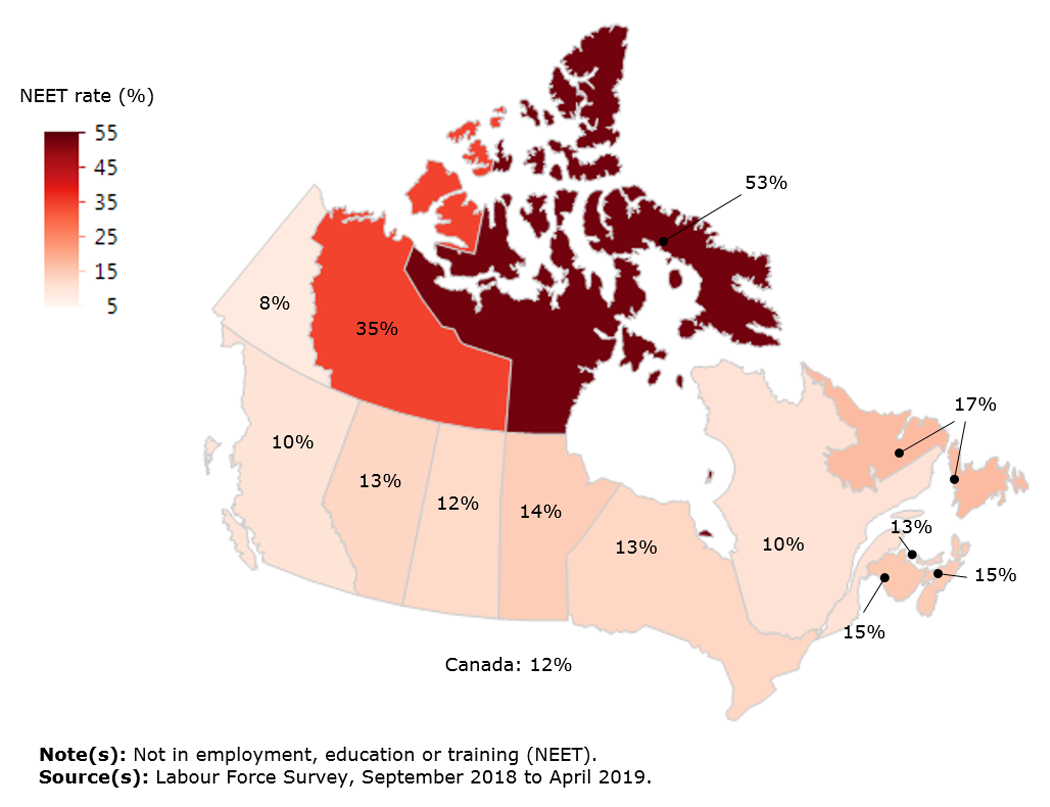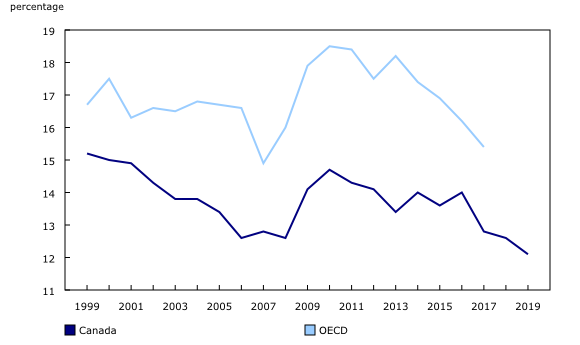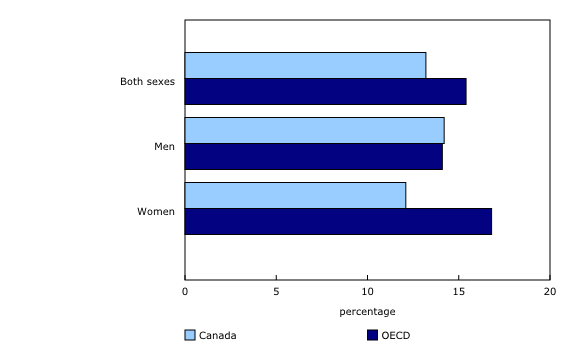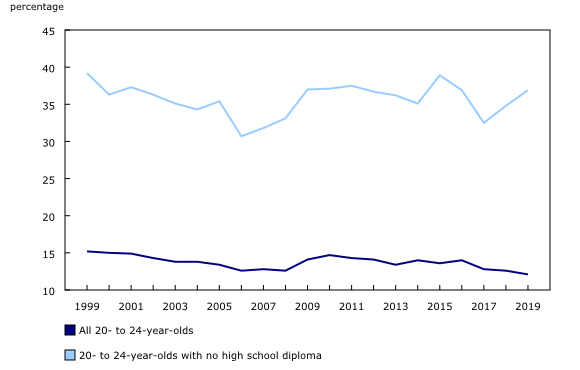Study: Making the transition from school to work: 20- to 24-year-olds not in employment, education or training (NEET) in Canada, 2018/2019
Archived Content
Information identified as archived is provided for reference, research or recordkeeping purposes. It is not subject to the Government of Canada Web Standards and has not been altered or updated since it was archived. Please "contact us" to request a format other than those available.
Released: 2019-07-05
This study highlights the importance of student support, perseverance and educational engagement for young Canadians aged 20 to 24 as those in this age group who do not have a high school diploma are particularly at risk of finding themselves not in employment, education or training (NEET).
The share of NEET Canadians aged 20 to 24 has ranged from 12% to 15% over the past two decades. In 2018/2019, the NEET rate was 12%, similar to the rate before the 2008/2009 recession. Of these 287,400 youth, 60% were out of the labour force (not looking for work) while 40% were unemployed (looking for work). The proportion of NEET youth is closely monitored as these youth may be at higher risk of low income or social exclusion.
However, these youth could be in a NEET situation for many reasons, such as taking a break between their studies and working, travelling, caring for children, volunteering or serving in their community. A recent study showed that about 3 in 10 people aged 15 to 29 who were in a NEET situation had done at least some amount of volunteering in the previous 12 months, while almost 4 in 10 women aged 25 to 29 in a NEET situation were caring for children as their main activity. In order to better measure activities such as volunteering or community service, Statistics Canada is revising the NEET indicator to better reflect the activities of young people who are not engaged in traditional work and school activities.
A new study, "The transition from school to work - the NEET (not in employment, education or training) indicator for 20- to 24-year-olds in Canada," is now available as part of the Education Indicators in Canada: Fact Sheet series and sheds light on young NEETs aged 20 to 24, both at the national and provincial/territorial levels. Previous studies in this series focused on 15- to 19-year-old NEETs and 25- to 29-year-old NEETs.
Men and women aged 20 to 24 were as likely to be in a NEET situation in 2018/2019
In Canada, in 2018/2019, women and men were represented in similar proportions among NEETs aged 20 to 24. However, among those in a NEET situation who are aged 20 to 24, women were 2.5 times more likely to be out of the labour market than unemployed, and men were twice as likely as women to be unemployed. Among young Canadians who were not in a NEET situation in 2018/2019, women were more likely to be in school than men, while men were more likely to be out of school and working.
Young women drive down the NEET rate in Canada
As has consistently been the case for the past two decades, Canadian women aged 20 to 24 had lower NEET rates (12%) than the average for women from Organisation of Economic Co-operation and Development (OECD) countries (17%) in 2017, the most recent year for which comparable data are available.
In fact, the Canadian NEET rate among 20- to 24-year-olds has been one to five percentage points lower than the average rate for OECD countries over the past 20 years.
Among the provinces, NEET rates range from 10% to 17%
Provincially, NEET rates ranged from 10% in Quebec and British Columbia to 17% in Newfoundland and Labrador in 2018/2019. Most provinces had rates comparable with the Canadian average of 12%.
However, Nunavut and the Northwest Territories had significantly higher NEET rates than the national average, reflecting the more challenging labour markets and greater challenges in accessing post-secondary education in these regions compared with the rest of Canada.
Map 1
 NEET rates for 20- to 24-year-olds, provinces and territories, 2018/2019" />
NEET rates for 20- to 24-year-olds, provinces and territories, 2018/2019" />
NEET rates for 20- to 24-year-olds, provinces and territories, 2018/2019
 NEET rates for 20- to 24-year-olds, provinces and territories, 2018/2019" />
NEET rates for 20- to 24-year-olds, provinces and territories, 2018/2019" />
Over one-third of young people aged 20 to 24 without a high school diploma are in a NEET situation
Young Canadians without a high school diploma have been overrepresented among NEETs for the past two decades. In 2018/2019, 60,600 youth, or 37% of those aged 20 to 24 who did not have their high school diploma, were in a NEET situation, with women (47%) more likely to be in this situation than men (30%).
These NEET youth aged 20 to 24 without a high school diploma were also more likely to have reported a permanent disability preventing them from working, than the overall NEET population of the same age. According to a recent study, most young people with a disability who were neither in school nor employed had a mental health-related disability, a learning disability, or both.
Young mothers and Indigenous people aged 20 to 24 have higher rates of NEET
The study also looks at various characteristics of those in a NEET situation, including being a parent, being Indigenous or being an immigrant, and whether the person lived in a rural or urban region.
Young women aged 20 to 24 with children were four times more likely (40%) to be in a NEET situation than women without children (10%) in 2018/2019.
Indigenous people (First Nations people living off-reserve, Métis or Inuit) aged 20 to 24 had a NEET rate of 23% in 2018/2019—almost twice the national average of 12%.
Immigrants and the Canadian-born aged 20 to 24 had similar NEET rates in 2018/2019. However, immigrant men and women in this age group were more likely to be in school and less likely to be working and out of school than their Canadian-born counterparts.
In general, young people aged 20 to 24 living in an urban or rural area have similar NEET rates. However, youth in rural areas were more likely to be working and out of school than urban youth in 2018/2019, while urban youth were more likely than rural youth to still be in school.
Products
The fact sheet "The transition from school to work - the NEET (not in employment, education or training) indicator for 20- to 24-year-olds in Canada," which is part of the Education Indicators in Canada: Fact Sheet series (81-599-X), is now available online.
Contact information
For more information, or to enquire about the concepts, methods or data quality of this release, contact us (toll-free 1-800-263-1136; 514-283-8300; STATCAN.infostats-infostats.STATCAN@canada.ca) or Media Relations (613-951-4636; STATCAN.mediahotline-ligneinfomedias.STATCAN@canada.ca).
- Date modified:



